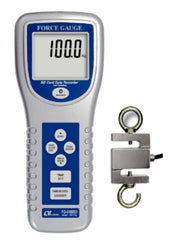Force meters are also known as force gauges or newton meters. But what is force, and how does a force meter measure this phenomenon?
Join us as we demystify what is force, examine different types of force meters, and present some excellent examples of force meters.
What is Force?
In physics, a force is anything that acts to change the motion of an object. Force can cause any item with mass to begin moving or change its velocity. Force is also sometimes described as a pull or a push.
|
The most basic equation relating force to other quantities is; |
How is Force Expressed for Measurement Purposes?
The SI unit of force is the newton (N), mass is the kilogram (kg), and acceleration is meters per second squared (m/s2). One-kilogram-force (kgf) is equal to a mass of one kilogram multiplied by the value approximating the average magnitude of gravity on Earth, which is 9.80665 m/s². Therefore, one kilogram-force (kgf) is equal to 9.80665 Newton (N).
Most force meters will display results in both Newtons and kilogram-force. Others may also have gram-force (gf) and imperial units such as pound-force (lbf) and ounce-force (ozf).
About Force Meters
Force meters are instruments designed to determine force precisely. There are two main types of force meter, the digital meter, and spring meter.
Spring Meters; are generally analogue and feature a spring with a hook on the end that attaches to the object you would like to measure. Spring force meters measure the amount of force exerted on the spring mechanism to extend it.
Digital Meters; employ either a load cell or a strain gauge. The software and electronics of the force gauge convert the electrical signal generated by either the load cell or strain gauge into a force value that then displays on the instrument's digital screen.
Applications exist for both spring and digital force meters in research and development, laboratory roles, product testing and quality assurance, and in various production-based applications.
Force Meter Examples
The Instrument Choice Scientists have detailed some prime examples of force meters, including the essential specifications of each instrument.
1 kg Compact Digital Force Gauge with Data Output
Product Code: IC-FG-3003
The IC-FG-3003 digital force gauge is the choice for straightforward, inexpensive tension and compression testing. Compact, yet full of features this meter provides the choice of three modes of operation:
- Track mode - displays live readings
- Peak mode - records the maximum values measured during testing; and

- Pre-set mode - activates user-defined high and low limit set points.
Specifications
Measurement Units:N, kgf, ozf, and lbf (depending on range)
Accuracy:±0.3% F.S.
Capacity: 1kg. Also available in a 5kg Capacity.
Data Logging: Yes. 500 point data collection capability can be viewed on display, sent to optional printer, or uploaded to software package for further analysis.
 FGD Force Gauge
FGD Force Gauge
Product Code: IC-FGD-1
The FGD series Digital Force Gauge measures compression and tension forces in industrial applications. All models include six standard attachments; a hook, flat, chisel, cone, v-notch anvil, and an 80 mm extension rod.
This force meter's package includes a USB charging cable as well as compatible software for data output. The IC-FGD-1 is available in a range of load cell capacities and display resolutions that will suit your required testing application.
Specifications
Measurement Units: N, gf, kgf, ozf, and lbf
Accuracy:±0.2% F.S.
Capacity: 2N, 5N, 10N, 20N, 50N, 100N, 200N, 500N or 1000N
Data Logging: 1000 entry internal data logger and software for output
Force Gauge with Data Logger (100 Kg)
Product Code: IC-FG6100SD
The IC-FG6100SD is a digital force gauge that captures highly accurate and highly  repeatable measurements. The device can log time-stamped sample data onto an SD card. From the SD card, you can download data to Excel directly (no additional software required), which makes it straightforward to graph, analyse, and share your collected data.
repeatable measurements. The device can log time-stamped sample data onto an SD card. From the SD card, you can download data to Excel directly (no additional software required), which makes it straightforward to graph, analyse, and share your collected data.
Specifications
Measurement Units: N, Kg and lb
Accuracy: ± (0.5 % + 0.1 Kg), within 23℃ ± 5℃
Capacity: 100kg
Data Logging: Expandable SD card option can store up to 1000 measurements(1 GB to 16 GB).
Conclusion
Force meters calculate the forces imposed on an object. The most common variety of force meters are digital, as they can easily log data and convert your measurements into a range of measurement units at the touch of a button.
If you would like to know more about force meters or need a hand finding the best meter for your application, contact one of the Instrument Choice Scientists. We're here to help! Call 1300 737 871 or email customer-service@instrumentchoice.com.au.
